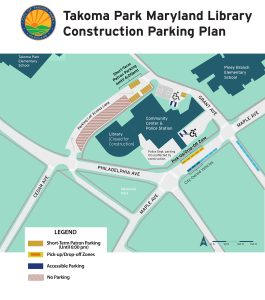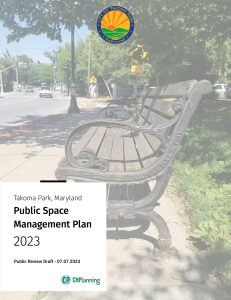Construction on the Takoma Park Library and Community Center Redevelopment Project is beginning in the next few weeks. After years of conversations and planning, we have information to share that will affect Library, Computer Center, and Community Center patrons.
The Library and Computer Center have relocated to ensure that access to our books, media, and computers will be available throughout this project. We will also continue to offer Books to Go curbside pickup at the new location and Books to You deliveries to Takoma Park residents.
Temporary Address:
Takoma Park Maryland Library
7505 New Hampshire Avenue, Suite 205
Takoma Park, MD 20912
Contact information:
newlibrary@takomaparkmd.gov
301-891-7259
Important dates:
- Mid-September 2023 (anticipated): The full Notice to Proceed will be issued, and exterior construction
will begin. - Beginning Monday, September 18, 2023, the Community Center back parking lot parking spaces will be severely limited, with a handful of short-term parking spaces for patrons using City services
- Spring 2025 (anticipated): The Library and Computer Center will open the new facilities and welcome everyone back to our original site at the intersection of Maple and Philadelphia Avenues.
Frequently Asked Questions:
1. Where can I go for updates? Please sign up for the City’s Insider or check the City’s website
2. Will books and computers still be available? Yes, please visit, call, or email the Library and Computer Center. We are also still ordering new books. If you would like to search our catalog, visit:
www.takomapark.info/
3. Where will Library programs be held? Library programs will primarily be held at the temporary location on New Hampshire Avenue, but please call or visit our website to verify. Other departments may relocate programs and activities as necessary; please contact those departments for more information.
4. Will Recreation programs and facilities reservations be available? A portion of Recreation programs have been temporarily moved to the Takoma Park Recreation Center (7315 New Hampshire Ave.) and we plan to keep a portion on site during the renovation. Most rentals at the Takoma Park Community Center have been discontinued due to limited parking. Please contact the Recreation Department at 301- 891-7290 for availability.
5. Will the Takoma Park Police Department be impacted? The Takoma Park Police Department will remain open throughout this process. They are open 24/7 for emergency services. If you have an emergency, please call 911 for the fastest response.
6. Will residents be able to access other Community Center services throughout construction? Passports, the Finance office, Housing and Community Development, and other City offices will remain open and accessible to residents for the majority of construction. Occasionally, there may be brief periods of closures for utility work. Please consider calling or visiting the City’s website to ensure that the office you intend to visit is open or to make an appointment.
7. Will parking be impacted? Parking at the Community Center will be limited. Please consider walking or taking public transportation to the Community Center when possible. See the site map below:

Print out a larger PDF version of the map here.
8. Will the City be communicating with the schools? Yes, we will be communicating regularly with nearby schools, and we will work with them to minimize the impact on dropping off and picking up students. More information will be available through the schools and on our website.
9. What changes can we expect to see in the near future? Construction equipment will be mobilized to the back parking lot of the Community Center starting on Monday, September 18, 2023. When work begins, four trees must be removed; we will attempt to repurpose these trees as furniture in the new building if the wood is found to be in suitable condition. Three trees are maple oaks, and one is a spruce. Once construction is completed, the plaque commemorating the Dr. Martin Luther King, Jr. memorial tree will be preserved and reinstalled on the grounds. Once the trees have been removed, the Library building will be razed and rebuilt. Other work will be taking place inside the facilities.
10. What work has already been completed? Several tasks have already been completed, including: the removal and storage of solar panels, disconnection of gas and water utilities at the construction site, hazardous material abatement, and interior demolition. The mosaic has been carefully removed and stored to ensure its preservation until it can be reinstalled on the new building’s façade.
We are excited to offer you new and improved facilities when we reopen in 2025. Thank you for being so patient while we transition to serve you better.



